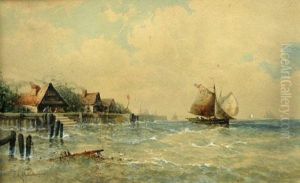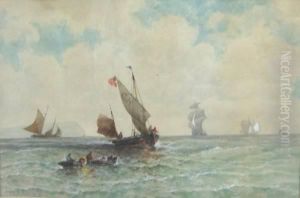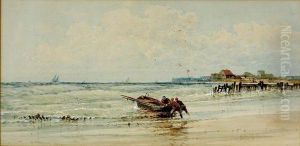Antoine Samuel Adam-Salomon Paintings
Antoine Samuel Adam-Salomon was a notable figure in the world of 19th-century French art, recognized primarily for his work as a photographer but also engaged in sculpture. Born in 1818 in La Ferté-sous-Jouarre, France, Adam-Salomon initially embarked on a career in sculpture before turning his attention to photography, a medium through which he garnered significant acclaim.
In the realm of sculpture, Adam-Salomon achieved recognition in the 1840s, displaying his works at the Salon, an influential French exhibition. Despite his success, he became increasingly captivated by the emerging art of photography, seeing in it a new means of artistic expression and portraiture. By the mid-19th century, he had shifted his focus entirely to photography, becoming one of the era's most celebrated portrait photographers.
Adam-Salomon's photographic work was distinguished by its innovative use of lighting and composition, qualities that drew inspiration from his background in sculpture. He had a unique ability to capture the essence of his sitters, who included many of the leading figures of his time in France, such as politicians, artists, and writers. His portraits were not just mere representations but were imbued with a sense of artistic depth and psychological insight, elevating the status of photography to that of a respected art form.
Throughout his career, Adam-Salomon contributed to the advancement of photography not only through his artistic achievements but also through his involvement in various photographic societies and exhibitions. His work was exhibited internationally, earning him recognition and awards, and helping to solidify his reputation as a pioneer in the field of photographic portraiture.
Antoine Samuel Adam-Salomon passed away in 1881, leaving behind a legacy that had a lasting impact on the art of photography. His work remains celebrated for its artistic quality and for the role it played in elevating photography to a respected and influential form of artistic expression during the 19th century.



![Galerie Contemporaine, Litteraire, Artistique. [album De La Galerie Contemporaine, Biographes Et Portraits, Revue Illustree], Paris: Ludovic Baschet, Issue No. 66, 1876](https://www.niceartgallery.com/imgs/352672/s/antoine-samuel-adamsalomon-galerie-contemporaine-litteraire-artistique-album-de-la-galerie-contemporaine-biographes-et-portraits-revue-illustree-paris-ludovic-baschet-issue-no-66-1876-3629610c.jpg)